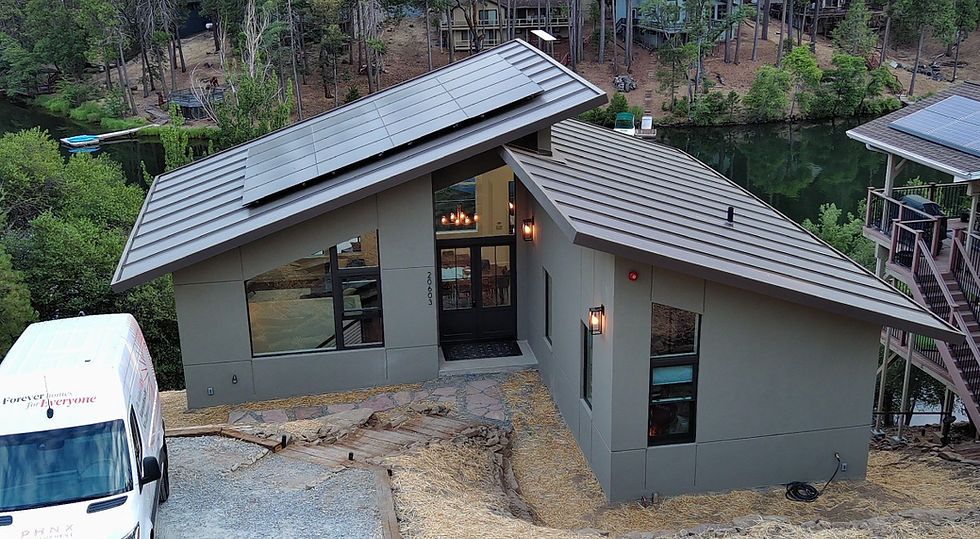Why home hardening isn't enough: the case for noncombustible construction
- Laurie Fisher

- Feb 7
- 3 min read
Updated: Feb 11

Many homeowners in wildfire-prone areas turn to home hardening techniques, believing they provide enough protection against fire. While these measures can improve resilience, they are not a substitute for building with noncombustible materials. Simply put, wood will always find a way to burn, no matter how much effort is put into fortifying it. That’s why PHNX Development takes a different approach—constructing homes to Type IA noncombustible code, eliminating the risk altogether.
A better way forward: building with noncombustible materials
PHNX founder, Architect Laurie Fisher, saw firsthand the devastation wildfires leave behind when she helped families rebuild after the 2017 Tubbs Fire in Santa Rosa. With a background in crisis intervention and trauma-informed care, Fisher recognized the deep emotional impact these disasters had on homeowners. When asked what they wanted most from their rebuilt homes, the response was clear: “We want a home that won’t burn down again.” But no such home existed—so she set out to create one.
PHNX homes are built to Type IA noncombustible standards, meaning they use materials that will not ignite under wildfire conditions. That's about as fireproof as a home can get! This approach eliminates the vulnerabilities inherent in traditional wood-frame homes, making PHNX homes the safest option for wildfire-prone areas.
Why home hardening alone isn’t enough
Many homeowners and builders turn to home hardening methods—installing ember-resistant vents, replacing wood roofs, and creating defensible space—to protect against wildfires. While these strategies can help, they do not offer the same level of protection as noncombustible construction. Here’s why:
Building codes define noncombustible construction for a reason. Home hardening strategies attempt to make traditional wood-frame homes more fire-resistant, but these methods still leave points of vulnerability. According to building codes, only Type I and Type II structures are considered noncombustible. No matter how many precautions are taken, wood is inherently flammable. Rather than spending time and money reinforcing combustible materials, it makes more sense to build with materials that don’t burn in the first place.
Home hardening saves lives and structures, but it’s not foolproof. Post-fire analysis has shown that home hardening can improve survival rates, but even well-hardened homes still burn. Since the Wildland-Urban Interface (WUI) guidelines were introduced in 2011, many homes have been built using modern fire mitigation measures—yet wildfires continue to claim thousands of structures each year. This shows that while home hardening can reduce risk, it cannot eliminate it.
Building a PHNX Home with noncombustible materials IS CHEAPER. Retrofitting a home with fire-resistant materials is a logical step for existing homes, but for new builds, it doesn’t make financial sense to invest in home hardening when a noncombustible home can be built from the ground up. A 2022 report from Headwaters Economics and the Insurance Institute for Business & Home Safety (IBHS) found that upgrading traditional construction with wildfire-resistant materials in Southern California added $27,080 to material costs—a 104% increase. This also raised the overall construction cost by 13%. Instead of investing in costly upgrades for a home that remains vulnerable, building a PHNX noncombustible home removes fire risk entirely at a competitive price.
Noncombustible homes unlock better insurance rates. In addition to better fire safety, PHNX homes provide significant insurance savings compared to hardened wood-frame homes. In November, we announced an alliance with Mercury Insurance, which offers special rates for PHNX’s Type IA homes. The first Mercury policy for a PHNX home saved the homeowners 41% on their insurance costs, compared to a California Fair Plan policy. This home was a fire rebuild in an area previously blacklisted by insurers due to extreme wildfire risk.
California law requires insurance companies to offer discounts to homes meeting “Safer From Wildfires” guidelines. However, discounts for home hardening vary widely. For example, USAA offers a 5% discount for homes in Firewise communities, while the Fair Plan offers 15% for hardened homes with defensible space. While these discounts help, they do not compare to the cost savings and security of a fully noncombustible home.
The choice is clear: build for the future with noncombustible materials
Home hardening is an important tool for improving wildfire resilience, but it has limitations. For homeowners rebuilding after a fire or constructing a new home in a wildfire-prone area, why take on the risk and added expense of hardening a combustible structure when a noncombustible home is an option?
With PHNX’s Type IA homes, there is no need to retrofit vents, reinforce siding, or upgrade roofing—because the materials used are already fireproof—by design. Choosing noncombustible construction is the safest, most cost-effective way to ensure that your home withstands the test of time.
Interested in learning more about building a noncombustible home? Contact us today to get started.








Comments